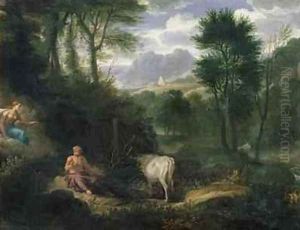Jan Gotlief Glauber-Myrtill Paintings
Jan Gotlief Glauber, also known as Johann Glauber or Joannes Glauber, was a Dutch Golden Age painter, born in Utrecht, the Netherlands, in 1646. He hailed from an artistic family; his brothers, Johannes Glauber and Diana Glauber, were also painters, with Johannes being the more famous of the two. Despite the prominence of his family in the arts, Jan Gotlief Glauber is not as well documented as some of his contemporaries, which means that details about his life and career are relatively scarce.
Jan Gotlief Glauber is primarily known for his landscape paintings, which often featured classical and mythological elements. His style was influenced by the dominant Baroque aesthetic of the time, characterized by dramatic use of light and shadow, rich colors, and dynamic compositions. He was also influenced by the Italianate landscape painters who were popular in the Netherlands during the 17th century, such as Cornelis van Poelenburgh, with whom his brother, Johannes, studied.
Glauber's professional life included time spent in various European cities. He is believed to have traveled to Rome, which was a common practice among Dutch artists of the period who wished to study the works of the great Italian masters firsthand and to soak in the vibrant Italian landscape. His work reflects this Italian influence, not only in the stylistic elements but also in the choice of subject matter, which often included ruins and classical architecture set within idyllic landscapes.
Despite his travels and the quality of his work, Jan Gotlief Glauber did not achieve the same level of fame as some of his peers. His works have occasionally been confused with those of his brother Johannes, which has made attributing some paintings challenging for art historians. Nevertheless, he contributed to the rich tapestry of Dutch landscape painting in the Golden Age, and his paintings still can be found in art collections and museums.
Jan Gotlief Glauber passed away in 1726. His legacy endures through the paintings that survive him and through the continued study of Dutch Golden Age art, which often uncovers new insights and appreciations for lesser-known artists like Glauber. His work remains a testament to the breadth of talent and the diverse perspectives that characterized this vibrant period of art history.
